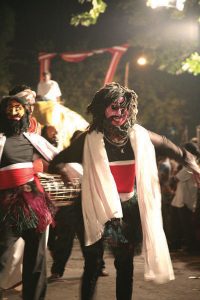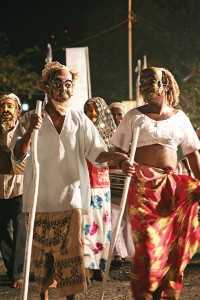-
Dancing Under the Stars…
January 2010
………is a contemporary idiom, to describe fête and celebration. But the basis of our very own colourful traditions of Kolam Maduwa, Thovil Pola, Nadagam Maduwa etc were far beyond mere celebration although these literally took place “under the stars”. These rites gradually evolved into different avenues leading to many other rich forms of art; art that celebrates life.
The ritual theatres of Sri Lanka trace their beginnings to the pre-Buddhist times and are amongst the oldest performances with an unbroken line of history. Despite the remote origins, they have grown over the years and as still practiced today, are generally nightlong performances addressed to numerous deities and demons of the folk religion; the entertainment springing from a predominantly agricultural way of life.
Simplicity has been a hallmark of the Sri Lankan way of life – so it is with theatre. Sri Lanka has no sophisticate tradition of court drama like in India. Instead early Sri Lankan “theatres” simply consisted of a temporary shed or a platform or an open space under the vast sky, within which the drama unfolded.
Until the 19th century, the theatre tradition in Sri Lanka existed mainly in the form of ritual performance and folk drama confining itself to the village. E R Sarachchandra attributes the absence of a sophisticated secular theatre tradition to the influence of Theravada Buddhism which “tended more towards solitary contemplation and the attainment of insight, than towards congregational practices or participation in community life” (1966 [1952]:7-8.
While it permitted the growth of poetry and painting, described by Sarachchandra as “solitary arts,” it frowned on more “communal arts” like that of drama. However it is assumed that this very reason was probably instrumental in the robust and diversified development of theatre we are privileged to experience today.
Despite being frowned upon as a communal art, the lively tradition of dramatic performance in the folk religion, closely tied to exorcist rituals and propitiation rites for gods and demons, existed and flourished within the confines of the village. The theatrical space called the “Ranga Mandala”, consisted temporary ‘stage sets’. The drama, closely tied to rituals, comprised long sections of verse narrative, chant, and dance with dramatized episodes, sometimes employing dialogue and mime.
The rituals of the large-scale performances, addressed the welfare of a whole village community. These usually are annual performances at harvest time or when the community is threatened by epidemics of infectious diseases linked with the supernatural world. The “bali –thovil” ceremonies on the other hand are smaller in scale focusing on an individual. They are performed on prescription by the ritual specialist or astrologer to cure those afflicted with sickness or misfortune. Here, chant and incantation receive far greater emphasis than dance and mime.
In these early ritualistic performances a raised platform and fixed seating are totally unknown. Although a roofed structure is built for certain performances, such as the Kohonba Kankariya and Gam Maduwa (shed or pavilion) this was never thought of as a playhouse. The audience sits or stands in a circle around the performance space, in the open air, demarcating the ‘concert’ area. For smaller scale rituals, such as Thovil, the Maduwa is not a prescribed requirement. Quite often the verandah and compound of the patient’s house easily serves as the acting space. The area thus obtained may be quite small. Moreover, it is a variable one, since the spectators move about constantly, changing the size of the circle.
The absence of a raised podium and a rigidly demarcated acting area indicates that the relationship between the audience and the performers is intimate. It also means that lighting is for illumination only – not for stage effects. Fire, is used as a ritual cleansing agent, as lighted torches, and lamps are regular “props” featured in these theatres.
Although regarded generally as formal solemn events, ritual theatres extrude an air of informality, for they are also important social gatherings and meeting places where the spectators moved freely to interact and rest as they were nightlong performances.
However, these theatres were not designed to draw continuous and consistent audience attention. These theatres were generated and nurtured by societies entirely different from those referred to as modern urban theatre. The traditional theatres articulated specific kinds of relations that the people had with each other, with the environment and with the “other world”. They married the sacred and the secular and overlaid religious ceremonial with blasphemous entertainment which was wholly sufficient in their context.
The most famous and undoubtedly the most majestic communal theatre is the performance known as the Kohomba Kankariya. Confined to the environs of Kandy, it is nothing but an extensive presentation of dance; a common set of ritual objectives and a single from of dance.
The times have changed, but not these theatres. The current revival interest in the traditional arts focuses only on the dance and musical aspects of ritual theatre and not in the transformation or modification of their subject matter. Yet, they survive to date, in remote villages which proves that, this theatre form has not lost all meaning and vitality. Of the several very important theatrical qualities they exemplify, the most considerable and noteworthy is the communal, collective base that is a pre-condition to their existence.
Sokari, is a theatre that lies outside the mould of religious belief and practice. It is an exclusively Kandyan performance. It is a rare transitional art form that has retained some ritual import despite a fully secular content. The act is performed as an offering to the Goddess Pattini and is a non-stop all night “show” beginning shortly after the evening meal. The place of performance is any open space with the characteristic circular movement. The players go round the arena in simple rhythmic step while narrating the story and stop to enact a scene. Its mimetic content is truly impressive in range and economy of use as done in the village setting.
‘Kolam’ denotes a further stage in the secularization of indigenous theatre. Begun as comic interludes and impromptu dialogues between masked dancers, they later became masked dance-dramas of a secular nature. These dramas centered round a loosely structured array of masked characters – fun figures drawn from everyday reality mocked and ridiculed through miming and chanting. In common with other native theatres, the Kolam is performed on any level piece of ground and dispenses with all stage paraphernalia. The kolam, gradually discarded the masks which were thought of as a hindrance, from the latter performances.
The introduction of the Nadagama to the Sinhala theatre marks a fruitful turning point. Unquestionably Dravidian in origin, it is identified by its music, story material, and its conception of theatre as a performance divorced from ritual observance. These plays were performed by the Catholics Missionaries to dramatize liturgical subject matter. The main physical innovation in this regard, was the use of a raised, covered stage – a temporary structure of piled earth, semi-circular in shape, sheltered by a thatch of coconut palm leaves. There was no front curtain and no sets. The musicians occupied a part of the stage, so did the narrator or Presenter, and sometimes singers who served as a chorus. The Nadagama was “discovered” by the modern theatrical writers as a promising resource only in the 1950’s. Its music thus brought a fresh dimension into Sinhala folk theatre.
A truly urban Sinhala theatre came into being only in the last decades of the nineteenth century with the Parsi theatre company. They portrayed a drama quite unlike that which was familiar to local audiences. Nurti as it was known was a blend of European and Indian dramatic modes and stagecraft. In terms of presentation, the Nurti adhered to the Western concept of an organized, scenic proscenium stage employing painted backdrops– and importantly an enclosed playhouse. Against the scenic splendor were placed gorgeously costumed personages. The Nurti was domesticated, practically overnight. Sinhala plays were written on similar material, and staged in the same manner to the very same music. Playhouses for Nurti were built in Colombo for its rapidly growing audience. Thus was born the first urban, commercial theatre in Sri Lanka. It flourished in the first two decades to find those who made a living out of the theatre, a stage-struck audience crowding the several playhouses in Colombo, and a new profession – that of playwrights. John de Silva (1857-1922) was a pioneer who fed the Nurti concept. The first state built theatre in Colombo bore his name.
The Theatre found stiff competition with the advent of “Bysecope” (cinema) in the 1930’s. Symbolically, the leading playhouse – The Tower Hall – was converted into a movie house, signaling the end of the brief but lively epoch of Sinhala urban theatre.
Throughout the Forties and the early Fifties, various experiments in dramatic writing and production were made along these lines. The significant breakthrough came in 1956 with a play popularly known as Maname.
Professor Edirriweera Sarachchandra, stunned the local theatre world with Maname -a dramatization of a Buddhist Jatake tale, already familiar to Kolam audiences, in the Nadagam style. Sarachchandra considered one of Sri Lanka’s greatest playwrights used Sinhala folk plays discarded as obsolete, to build a stylized tradition of drama that was also influenced and inspired by Sanskrit, as well as Japanese and Chinese dramatic traditions.
Maname stimulated the Sinhala theatre not only by attracting a new audience but also encouraging the Sinhala playwrights and directors to use any folk element that suits their purpose, without strictly adhering to one single form. Such free experimentation with traditional forms has enabled the Sinhala theatre to build up a rich storehouse of theatrical tools. But the indigenous resources are far from exhausted; in fact, they have only been touched.
Sources:
• Goonatilleka, M. H, (1990) The rural theatre and social satire of Sri Lanka, Ceylon Tourist Board
• Gunawardana, A. J, (1976) Theatre in Sri Lanka (The culture of Sri Lanka), Dept.of Cultural Affairs
• Gunawardana, A.J, Kolam, Sokari & Nadagam Theater in Sri Lanka
• www.lankalibrary.com/rit/kolam.htm (accessed date 9th December 2009
• http:en.wikipedia.org/wiki/theatre_of_Sri_lanka (accessed date 9th December 2009)
• Fernando, W. T. A.L., Did Sinhala Drama Originate in Christmas? www. lankalibrary.com/rit/drama.htm
(accessed date 9th December 2009)
• Obeyesekere, Ranjini Essays: The Sinhala Theatre of Sri Lanka, http://www. artdsrilanka.org/essays/theatre/index.htm
(accessed date 9th December 2009)
Photographs courtesy of BT Photo Images















